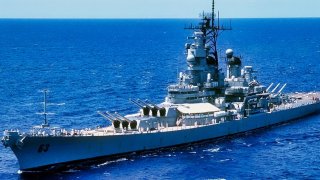Iowa-Class Battleship USS Missouri Sailed Though a Hurricane to Fight North Korea
The USS Missouri (BB-63), renowned for hosting Japan’s surrender in WWII, played a crucial role in the Korean War. Ordered to the Pacific in 1950, the battleship braved a hurricane en route, then provided critical bombardment during the Incheon landings and North Korean retreats.
Summary and Key Points: The USS Missouri (BB-63), renowned for hosting Japan’s surrender in WWII, played a crucial role in the Korean War. Ordered to the Pacific in 1950, the battleship braved a hurricane en route, then provided critical bombardment during the Incheon landings and North Korean retreats.
-Missouri's firepower was instrumental in the Hungnam evacuation, protecting UN forces against advancing Chinese troops. After her initial deployment, the battleship returned for more shore bombardments, firing thousands of rounds in support of UN efforts.
-Though decommissioned after the war, Missouri was reactivated in the 1980s, even serving in Operation Desert Storm.
USS Missouri's Korean War Heroics: From Battleship to Bombardment Legend
The Iowa-class battleship USS Missouri (BB-63) is best remembered as the venue for Imperial Japan’s unconditional surrender to the Allies, which officially ended the Second World War. But aside from hosting one of world history’s most consequential capitulations, the Missouri served for many more years – including, notably, in the Korean War.
USS Missouri: Deployed to Korea War
When President Truman ordered US forces to intervene in Korea, on behalf of the United Nations, the Missouri was stationed in Norfolk, Virginia. Quickly, as part of the naval mobilization that Truman ordered, Missouri was transferred to the Pacific Fleet, and deployed to the Korean Peninsula on August 19, 1950.
However, the trip from Virginia to Korea did not go smoothly. Because the deployment was so urgent, the Missouri was sailed straight through a hurricane off the coast of North Carolina. The howling winds blew helicopters from the Missouri’s stern and caused damage sufficient to require that she be docked for repairs once reaching Pearl Harbor, Hawaii.
After a week’s worth of repairs in Hawaii, the Missouri set forth, finally arriving in Korean waters on September 14, 1950. The Missouri was the first US battleship to reach the conflict, becoming the flagship of Rear Admiral Allan Edward Smith. Immediately, the Missouri was used to bombard Samchok, in an effort to divert North Korean troops and attention from the UN’s Incheon landings. A few days later, Missouri sailed to Incheon, where she began bombarding North Korean troops as they retreated north.
Command of the Missouri would transfer from Smith to Rear Admiral John M. Higgins, to Vice Admiral A.D. Struble. Under Struble, in October 1950, the Missouri served as the flagship of the Seventh Fleet, and was used to escort the aircraft carrier Valley Forge, and to conduct bombardment missions in the Chongjin and Tanchon areas. The same month, legendary comedian Bob Hope visited the Missouri, on a USO tour, and gave three performances for the crew.
In late October, China’s People’s Liberation Army launched 380,000 soldiers on a full-scale assault, in support of North Korea, against UN troops advancing from the south. The UN troops were forced to retreat. The Missouri was called upon to provide gunfire support during the resultant Hungnam evacuation (also known as the Miracle of Christmas).
Through 1951, Missouri was used for carrier escort and shore bombardment. In March, the battleship was ordered back to port in the US. During the Missouri’s deployment she fired 2,895 sixteen-inch rounds and 8,043 five-inch shells. After sailing home, Missouri was docked at Norfolk for an overhaul that lasted until January 1952. Missouri would not arrive back in Korean waters until late 1952, where she would be used to provide naval gunfire support, or “cobra strikes.”
The Missouri’s last engagement in the Korean War was on March 25, 1953, in the Kojo area. Missouri was sent home, soon thereafter, and eventually deactivated in 1955. The famous battleship joined the reserve fleet and became a tourist attraction, where 250,000 visitors per year viewed her “surrender deck.”
Curiously, the Missouri would be reactivated in the 1980s, when President Ronald Reagan decided to expand the US’s naval force. And the Missouri, once the sight of the Japanese surrender, and participant in the Korean War, would participate in Operation Desert Storm, firing Tomahawk missiles at Iraqi targets.
About the Author: Harrison Kass
Harrison Kass is a defense and national security writer with over 1,000 total pieces on issues involving global affairs. An attorney, pilot, guitarist, and minor pro hockey player, Harrison joined the US Air Force as a Pilot Trainee but was medically discharged. Harrison holds a BA from Lake Forest College, a JD from the University of Oregon, and an MA from New York University. Harrison listens to Dokken.
Image Credit: Creative Commons.


